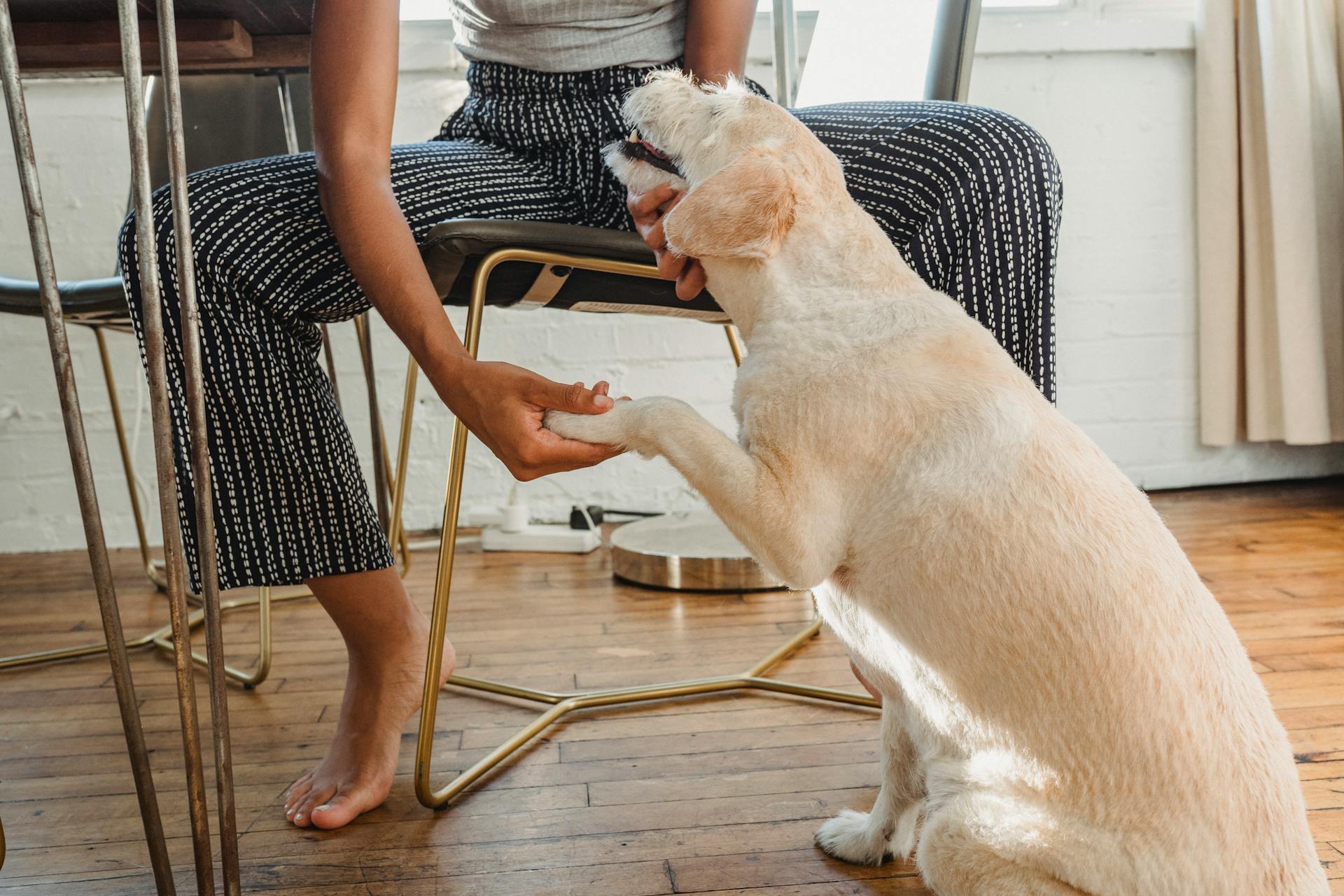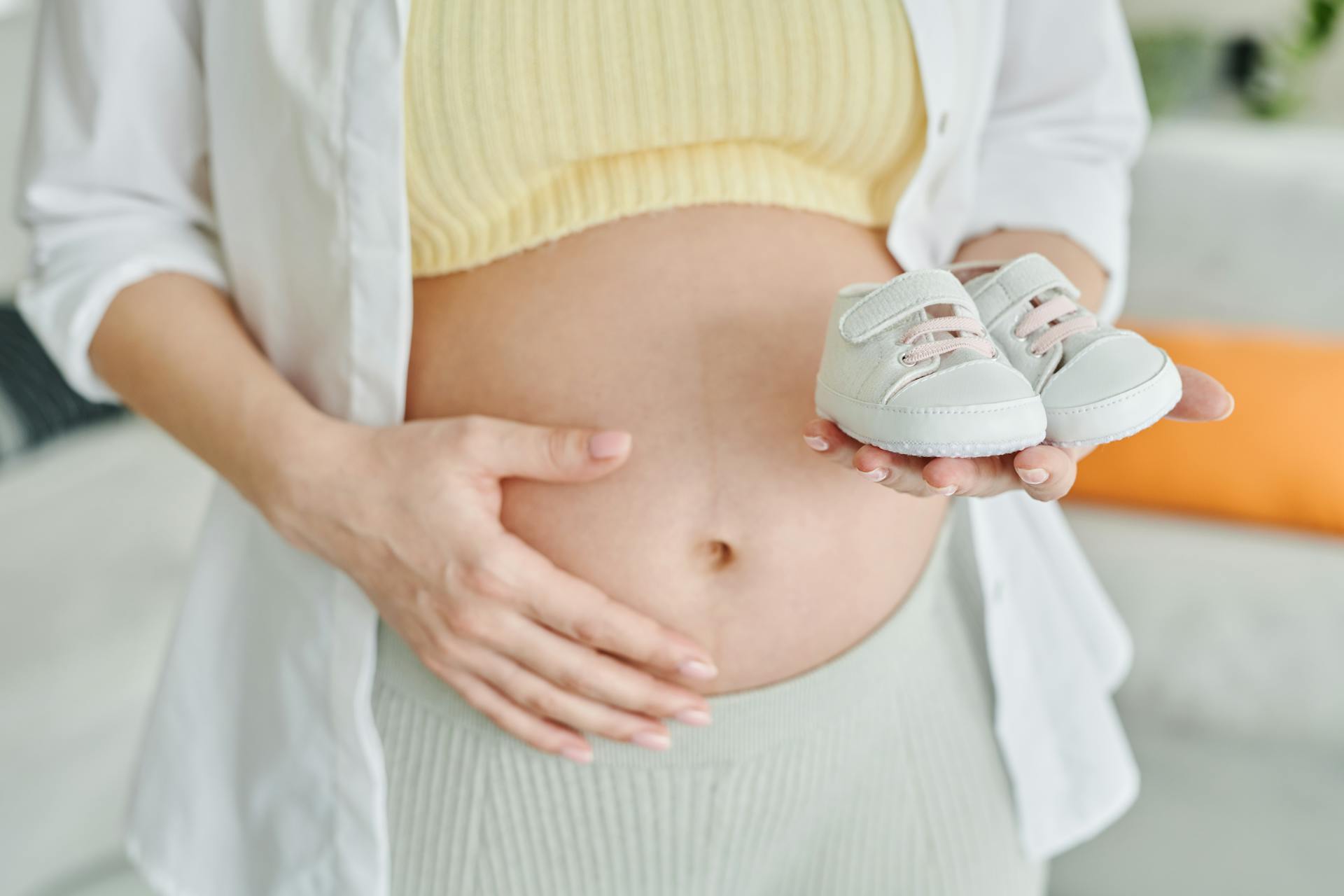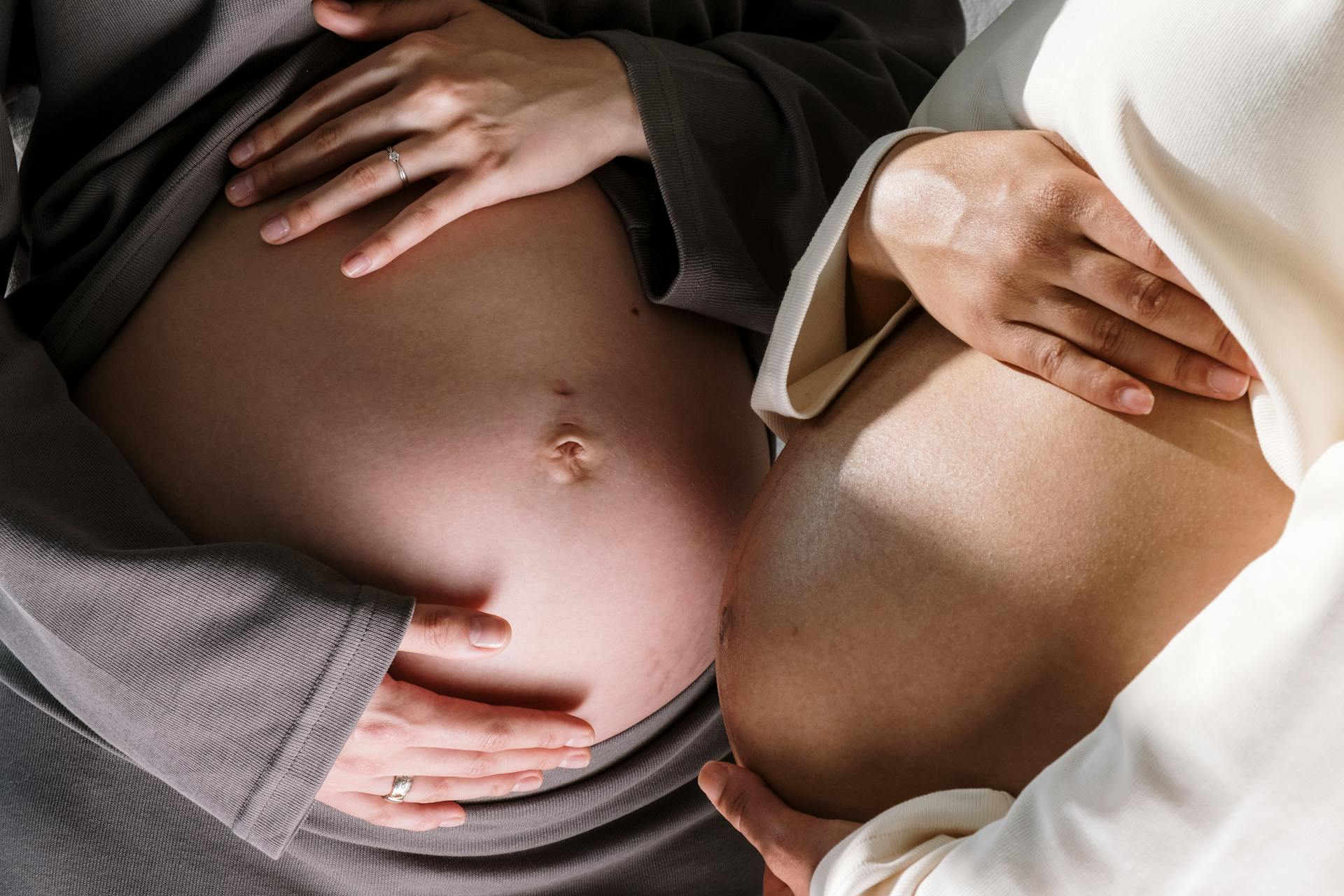
After mating, a female dog will typically experience a 54-80 day gestation period, during which her body will undergo significant changes to prepare for whelping.
Her appetite may increase, and she may start eating more to support the growth of her puppies.
As the due date approaches, her abdomen will expand to accommodate the developing puppies, and she may start to show a more prominent belly.
She may also become more restless and anxious as the whelping process nears.
A different take: Female Dog Whelping Signs
Physical Changes
As you wait for the confirmation of a pregnancy, keep an eye out for physical changes in your female dog.
About 3 weeks after mating, you might notice her nipples growing larger and changing color due to the hormone prolactin.
In the final two weeks of pregnancy, the nipple enlargement is more noticeable in first-time mothers.
Fluid retention can make her look like she's gained weight, but real weight gain only starts in the final three weeks of pregnancy.
It's essential to monitor her food intake and avoid overfeeding, as both overweight and underweight mothers pose a risk to themselves and their puppies.
You'll need to see a vet 4 weeks after conception to confirm the pregnancy and have x-rays taken to determine how many puppies to expect.
For your interest: Sudden Weight Gain in Female Dog
Behavior and Appetite
After mating, you may notice some changes in your female dog's behavior. These changes are natural and indicate her instinctive preparation for motherhood. Behavior changes in dogs after they have mated really depends on the individual dog. You may see her become more impatient and snappy with other dogs, so it's always good to give her more space to herself.
Some dogs may become more clingy and needy, while others may become more lethargic and prefer to nap most of the time. You may also notice that she becomes significantly sweeter or gentler. In many dogs, you may not notice any major behavioral changes at all, especially in the first few weeks.
A female dog's appetite may also change during pregnancy. Some dogs experience an increase in appetite, while others may become more selective. Some dogs even experience a temporary decrease in their appetite. Providing a balanced diet to meet your dog's nutritional needs is essential.
A different take: Why Does My Male Dog Lick My Female Dogs Pee
Changes in Behavior

As your dog's pregnancy progresses, you may start to notice some changes in her behavior. She may become more affectionate, seeking more attention and interaction from you.
Some dogs may exhibit nesting behavior, which is a sign that labor is near. However, this is usually seen towards the end of the pregnancy.
Dogs can be quite individual, and behavior changes may vary from one dog to another. You may see your dog become more impatient and snappy with other dogs, so it's a good idea to give her some extra space.
Other dogs may become more clingy and needy, wanting to be close to you at all times. Some may even become more lethargic and prefer to nap most of the time.
On the other hand, some dogs may become significantly sweeter or gentler, showing a softer side to their personalities.
Related reading: When Do Male Dogs Become Fertile
Changes in Appetite
Changes in Appetite can be a sign of pregnancy in dogs. Some dogs experience an increase in appetite during this time.

A female dog may become more selective about her food, which can be a sign of pregnancy. This is because her nutritional needs are changing.
Providing a balanced diet to meet your dog's nutritional needs is essential during pregnancy. This will help ensure the health of both the mother and her puppies.
Real weight gain in pregnant dogs only starts in the final three weeks of pregnancy.
Pregnancy and Gestation
Pregnancy in dogs typically lasts around 63 days, although it can vary. This duration starts from the moment of conception, when the embryos migrate and attach to the uterus.
During this time, the puppies develop and grow, and it's essential to monitor your dog's health and well-being. Early signs of pregnancy in dogs usually start around three weeks after mating.
Behavioral changes like lethargy or clinginess, irritability with other dogs, and changes in appetite are some of the early signs of pregnancy. Enlarged nipples that change color and vomiting are also common symptoms.
A fresh viewpoint: Bladder Infection Female Dog
Ultrasound is a non-invasive and safe imaging technique that can confirm pregnancy in dogs and estimate the number of puppies present. It works as early as 25-30 days after mating and is generally more accurate after 35 days.
Here are some key facts about ultrasounds for pregnant dogs:
- It can confirm pregnancy and estimate litter size.
- It can provide valuable information about puppies' development, position, and well-being.
- It can help detect abnormalities or complications.
A veterinarian can perform an ultrasound or an X-ray to detect the puppies around three to four weeks after mating. These diagnostic tools are essential for confirming pregnancy and ensuring the health of both the mother and the puppies.
Recommended read: Unique Dog Names for Female Puppies
Health and Nutrition
Proper nutrition is crucial for a pregnant dog's health and the development of her puppies. As a result, you should feed her a high-quality, nutrient-rich dog food that meets her increased energy needs.
A pregnant dog requires more calories and nutrients than usual, so you may need to increase the amount of food you provide. This will help ensure she's getting enough protein, calcium, and other essential nutrients.
In some cases, your veterinarian may recommend supplements to support the development of the puppies, but this should be determined on a case-by-case basis.
Post-Mating Nutrition
Proper nutrition is crucial for a pregnant dog's health and the development of her puppies.
A pregnant dog's diet should be nutrient-rich, as she needs extra calories to support fetal growth.
She may gain weight due to increased appetite, so monitor her food intake and adjust as needed.
A pregnant dog's nutritional needs are best met with a high-quality commercial dog food or a balanced homemade diet.
Morning sickness can lead to a decrease in appetite, so be prepared to offer smaller, more frequent meals.
In addition to a balanced diet, a pregnant dog may benefit from supplements, but it's essential to consult with a veterinarian before adding any new nutrients.
You might like: Female Dog Frequent Urination Small Amounts
Female Vomiting After Mating
If your female dog is vomiting after mating, it's essential to provide her with rest and comfort to aid in her recovery.
Providing your dog with rest is crucial for her recovery.
Make sure she doesn't have the opportunity to mate with any other dogs during this period, as oestrus can continue for several more days.
Responsible breeding practices can help prevent unwanted litters and contribute to the dog's overall welfare.
Check this out: Recovery Time for Spaying a Female Dog
Timing of Desexing After Oestrous Cycle
Dogs can be desexed while they're in season, but it's generally recommended to wait 8 weeks after the start of their last oestrous cycle.
This timing allows the blood supply to the uterus and ovaries to return to normal, making the surgery less complicated.
Veterinary Care
Pregnancy is a difficult business, and it's best to be able to speak to your vet throughout the process, just like a pregnant human has regular check-ups and appointments with their doctor.
Don't hesitate to contact your veterinarian with questions or concerns about your dog's health or mating process. Remember, breeding dogs is best done responsibly and under the guidance of experienced professionals.
Veterinarians commonly use ultrasound and X-ray imaging to confirm pregnancy in dogs, which helps gather additional information about the developing puppies.
Related reading: Best Female Dog Names Unique
When to Consult Your Vet After Mating
Pregnancy in dogs can be a challenging process, and it's essential to have your veterinarian's guidance throughout. Don't hesitate to contact your vet with questions or concerns about your dog's health or mating process.
Curious to learn more? Check out: Dog Names Female Start with S
Regular check-ups and appointments with your vet can help ensure your dog's health and well-being during this time. Just like human pregnancies, dog pregnancies require close monitoring to prevent potential complications.
Breeding dogs is best done responsibly and under the guidance of experienced professionals. This helps ensure the health and well-being of both the mother and the puppies.
If you're not planning to breed your dog, spaying or neutering is an important consideration to prevent unplanned litters.
Ultrasound and X-Rays
Ultrasound and X-Rays are two common imaging techniques used by veterinarians to confirm pregnancy in dogs.
Veterinarians use ultrasound and X-ray imaging to gather additional information about the developing puppies. These scans help confirm pregnancy, determine litter size, and detect any potential problems.
Ultrasound is a non-invasive and safe imaging technique that uses sound waves to create images of the inside of your dog's body. It can confirm pregnancy and estimate the number of puppies present.
Ultrasound works as early as 25-30 days after mating, but it's generally more accurate after 35 days when the puppies' structures become more visible.
During an ultrasound, the veterinarian applies gel to your dog's abdomen and uses a handheld transducer to emit sound waves. The waves bounce back and create images of the uterus and developing puppies on a screen.
The veterinarian will examine the images to identify signs of pregnancy, such as gestational sacs or fetal heartbeats. They can also estimate the litter size based on the number of visible sacs or puppies.
An ultrasound can provide valuable information about the puppies' development, position, and well-being. It can also help detect abnormalities or complications.
Here are some key facts about ultrasound:
- Ultrasound can confirm pregnancy in dogs as early as 25-30 days after ma
It's generally more accurate after 35 days when the puppies' structures become more visible.
Ultrasound can estimate the number of puppies present.
It can provide valuable information about the puppies' development, position, and well-being.
Ultrasound can help detect abnormalities or complications.
Physical Activity and Rest
As your female dog adjusts to her new pregnancy, finding the right balance between physical activity and rest is crucial. She needs to get enough rest to ensure the health and well-being of herself and her puppies.
Pregnant dogs need more sleep, so let her take those well-deserved naps. Make sure she has a quiet area where she won’t be disturbed. A calm and peaceful environment is beneficial for her well-being.
You can create a comfortable environment for your pregnant dog by setting up a quiet and cozy spot for her to relax. This can be a soft bed or a designated area where she feels safe and secure.
Here are some tips to help you create a restful environment for your pregnant dog:
- Provide a quiet and cozy spot for your pregnant dog to relax.
- Let her take those well-deserved naps in a quiet area.
- Minimize loud noises, sudden movements, and stressful situations.
Regular veterinary check-ups are also important to ensure the pregnancy progresses well. Your vet can guide rest and activity levels specific to your dog’s needs.
Frequently Asked Questions
How many days will a female dog let a male mount her?
A female dog will typically not allow mating until 7-10 days into her estrus cycle, when she becomes more receptive to male advances.
How do I know if my female dog mated?
To determine if your female dog mated, a scan 3 weeks after the possible mating is necessary. Alternatively, a veterinarian can administer a medication called Alizin to prevent pregnancy if desired.
Sources
- https://pawsafe.com/blogs/dog-healthcare/what-to-expect-from-female-dog-after-mating
- https://vcahospitals.com/know-your-pet/breeding-for-pet-owners-estrus-and-mating-in-dogs
- https://www.vetwest.com.au/pet-library/breeding-what-to-expect-after-mating/
- https://pawsandmorevet.com.au/female-dog-in-heat/
- https://www.vetwest.com.au/pet-library/reproduction-in-dogs/
Featured Images: pexels.com


